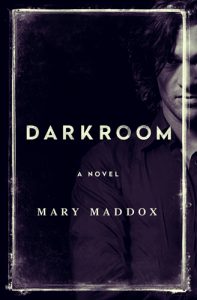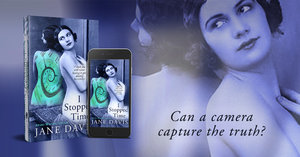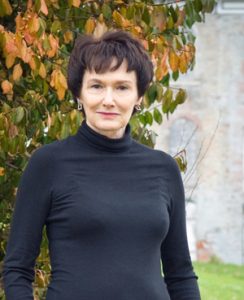Today, I’m delighted to welcome Mary Maddox to Virtual Book Club, the interview series in which authors have the opportunity to pitch their books to your club.
Mary is a suspense, horror, and dark fantasy novelist with what The Charleston Times-Courier calls a “Ray Bradbury-like gift for deft, deep-shadowed description.” Born in Soldiers Summit, high in the mountains of Utah, Maddox graduated with honors in creative writing from Knox College, and went on to earn an MFA from the University of Iowa Writers’ Workshop. She taught writing at Eastern Illinois University and has published stories in various journals, including Yellow Silk, Farmer’s Market, The Scream Online, and Huffington Post. The Illinois Arts Council has honored her fiction with a Literary Award and an Artist’s Grant.
The book we’ll be discussing today is Darkroom and Mary has kindly allowed me to reproduce the prologue. So here’s your teaser.
Prologue
Some photographs speak for the dead, but their meaning may be elusive. You can’t know for certain what’s happening outside the frame or what happened before and after the image froze.
Look at these four black-and-white photographs.
In the first, a young man and woman crane their necks at the camera. They sit on a blanket with a Navajo pattern, surrounded by the remains of a picnic—bottles of Corona, a half-eaten hard roll, an open jar of Greek olives, a hunk of cheese on a board, a knife. A metal pipe used for smoking hash. In the upper edge of the frame, beyond the blanket, are meadow grasses and rangy wildflowers. Stalks and blossoms of the wildflowers are entwined in the woman’s hair. They have begun to wilt.
The couple are in their early twenties, no older. The young man’s head seems too big for his body. He has a round face, a snub nose, and an undersize mouth tight with disapproval—of the bothersome flies or having his picture taken, or something far worse that he would call evil. The woman’s mouth, dark with lipstick, hangs open. Her forehead is creased. She gazes beyond the camera to where something has drawn her attention, pulling her out of the framed moment.
She sees it coming and is afraid.
In the next photograph, the couple are gone. A creek flows under a barbed-wire fence. The angle suggests the photographer has crouched on the bank and aimed the camera low over the water, upstream. Close up, the water is transparent down to the riverbed. Beyond the fence, shadowed by trees, the water darkens and winds across the frame, drawing your eye to the edge.
The creek in the third photograph is more narrow, rippling with current as it tumbles downhill. Another low angle, but this time the photographer aims the camera across the water and into trees. No focal point, it seems at first. But keep looking. After five seconds, maybe longer, your eye settles on a cross carved into the trunk of an aspen. The cross is several inches high yet no more prominent than the black knots and threads of lichen around it. But once seen, its wrongness stands out—the single unnatural detail in a landscape too wild to be framed. The knife cuts are fresh.
The last photograph points down at a patch of forest floor that also looks wrong in subtle ways. Pine needles are unsettled, not packed as they would be after lying together for a long time. The scattering of cones and twigs seems deliberate, like coconut sprinkled on a cake. Despite the unusual fluffiness of its cover, the ground looks sunken, as if the cake had fallen while baking. No marker distinguishes this spot from any other on the mountainside. The photographer has led you from the border into the heart of nowhere, trusting you’ll care enough to follow the trail.

Cover design by Pete Garceau
Click here to look inside or buy
(Free for Kindle Unlimited subscribers)
‘Maddox’s photographic way of creating a story is both ingenious and unusual, putting a different spin on the crime genre.’
Q: Doris Lessing says that it was moving from one country to another at an early age that made her a writer. Is this something you can relate to?
I definitely can. When I was seven, my parents divorced and my brother and I went to live with our paternal grandmother 800 miles away in California. I saw the ocean for the first time. The sights, sounds, and smells of San Diego were altogether different from those of Utah. And I learned that the world, which I’d experienced as dependable and immutable, could collapse at any time.
Q: What is it about Darkroom that you feel makes it particularly suitable for book clubs?
Firstly, it’s a crime thriller written primarily to entertain with a suspenseful and briskly paced plot. But its characters have enough depth and complexity for a discussion of their motives and the degree to which the cruel or selfish ones are deserving of sympathy. The Colorado landscape is memorable and invites consideration of the ways that setting colors the reader’s experience of the story. Thematically, Darkroom invites questions about the obligations of friendship, the meaning of courage, and the possibility of redemption for even the worst people.
I love talking about my books and would be glad to visit any book club that would have me, either in person or on Skype.
Q: Why do you think crime fiction has moved from whodunnit to why did they do it?
The whodunnit relies heavily on plot. The writer obscures the killer’s identity while providing enough clues so that readers don’t feel tricked when the unmasking finally comes. This need for concealment limits the possibility for character development, especially the killer’s. Usually the whodunnit relies on a twist, an unexpected event or revelation that catches readers by surprise. Twists are gratifying when they’re done right. But they have to make sense. Some writers withhold information in artificial or manipulative ways, or introduce an entirely new character as the killer.
The question of “why they did it,” or motive, relies on character development. In this kind of crime fiction, the villain may be known from the beginning. For readers, the pleasure comes from exploring the darkness of the villain’s mind. The suspense lies in whether and how the villain will be stopped before he claims another victim. This kind of crime fiction also has twists. The killer seems to target one character but kills another instead, or unexpectedly acts out of remorse. But these changes shouldn’t come out of nowhere. The writer has to create characters who are complex enough to surprise readers without insulting their intelligence.
Q: Your protagonist is Kelly Durrell. What five words best describe her?
Decent: Kelly shares her home with Day Randall, the homeless photographer who becomes her best friend. When Day disappears in sinister circumstances, Kelly tries to find out what happened to her.
Alone: Until Day happens along, Kelly has no close friends even though she’s lived in Boulder, Colorado for several years. She’s not lonesome in the sense of yearning for company. She’s content to spend solitary evenings reading.
Romantically challenged: She has an unerring instinct for choosing the wrong men, from a heavy drug user in high school to a divorced art professor who mostly wanted a babysitter for his daughter. She’s attracted to Cash Peterson, the detective who helps her search for Day, but both are a bit awkward when it comes to dating. Their romance doesn’t get very far–certainly not as far as some readers hoped.
Alienated: Kelly is alienated from her family because of her infatuation with the drug dealer, her insistence on studying art in college, and her decision to take a job 1000 miles from home. Recently her younger sister died in a car crash. Devastated by the death, their mother blames Kelly for going her own way and for surviving when her sister didn’t.
Tough: Outwardly Kelly doesn’t appear to be tough, but she stands up to her bullying superior at the art museum where she works, and when her investigation puts her in danger, she shows courage and resourcefulness.

Photo by Linda Smogor
Q: Why did you decide to switch to different characters’ points of view?
I switch points of view when it seems like the best way to tell the story. After reading an early draft of Darkroom, my developmental editor warned that multiple points of view can reveal too much too soon and ruin the suspense for readers. They also allow Kelly to be passive since readers learn crucial information through other characters rather than through her efforts at figuring it out. His advice prompted me to cut several scenes, eliminating the points of view of two minor characters.
I love having a good editor! My writers’ critique group and beta readers provide invaluable feedback, but my editor is thorough and incisive in a way the others can’t be.
Q: Do you feel under pressure to make your main characters likable?
Readers complain a lot about unlikable characters. I used to resent the pressure. It seemed like a constraint on my creativity. Then I realised that as a reader I preferred stories with at least a few likable characters. The trouble is that likable sometimes equals bland. Writers avoid giving their protagonists any weaknesses or unattractive traits out of fear that readers might dislike them. But a boring character is worse than an unlikable one.
Q: You’ve already mentioned that the book is set in Colorado but how did you decide on its setting?
Darkroom is set in Boulder, Colorado and the surrounding area. I once spent a summer in Boulder and loved the area for its natural beauty and the city for its progressive bent and lively arts scene. Since that time, Boulder has become a more expensive place to live.
Q: Tell us a little about the major areas you had to research for the novel.
Before beginning Darkroom, I spent several days in Boulder to see how the area had changed since I lived there. The time I spent driving around Nederland and Estes Park was especially useful in creating the setting.
The Museum of the Rockies where Kelly works is loosely based on the Eiteljorg Museum of American Indians and Western Art in Indianapolis, so I made a couple of enjoyable trips there. Unlike my fictional museum, the Eiteljorg has extensive displays of Native American art and history. It’s worth your time if you’re ever in Indianapolis.
I spent an hour researching the art displays at the Denver International Airport. Blucifer, a nickname for the gigantic Blue Mustang outside the airport, has a haunted past. Its creator, Luis Jiménez, died when part of the sculpture fell on him.
Q: Patricia Cornwell took a job in a morgue to research her books. What is the darkest place your research has taken you?
For my first novel, Talion, I did a lot of reading about serial killers. Most of them are full of rage. No surprise there. They’re driven by the need to control other human beings completely. They get pleasure from torturing them. In Perfect Victim by Christine McGuire and Carla Norton, I read about Cameron Hooker, who kept a girl in a box not much bigger than a coffin. He brought her out for rape and torture, meals and bathroom breaks, but most of the time she lay in the dark. He kept her for seven years.
I have quite a few grisly images locked in my head. They have a nasty way of crawling to the surface when I feel at peace.
After finishing the first draft of Talion, I sent the manuscript to an old college professor of mine, an accomplished writer. He emailed me a few days later, saying the first chapter was giving him nightmares and he wasn’t going to read the rest. Just as well. It gets much worse. Yet nothing in the novel is nearly as horrible as the atrocities that some human beings inflict on others.
Darkroom contains fewer violent scenes, but they’re rather graphic. In one, Gregory Tyson (Gee) remembers accompanying his drug dealing older brother when the latter tortures a buyer who cheated him. The scene’s tension arises from Gee’s ambivalence. Gee wants to be like his merciless brother, but he shrinks from the brutality.

Photo by Jamie Newell
Q: Joanna Russ wrote, “Not only is female experience often considered less broad, less representative, less important, than male experience, but the actual content of works can be distorted according to whether the author is believed to be of one sex or the other.” Do you wish to comment?
For many years, I taught literature to freshmen students at Eastern Illinois University. Whenever we discussed a story by the American writer Flannery O’Connor, they were surprised to learn that she’s a woman. They perceived her terse prose and unsentimental treatment of the cruel and grotesque as masculine. My male students especially looked a bit stunned to learn that a woman wrote “A Good Man Is Hard to Find,” a story about an old woman whose foolishness leads to her and her family being murdered by outlaws. O’Connor apparently understood that readers would respond to her work differently if they knew she was female. She could have written under her full name, Mary Flannery O’Connor.
My horror novel Talion contains scenes of cruelty and graphic violence. One of the point-of-view characters is a serial killer who enjoys torturing women. A few readers have expressed surprise that a woman would write that kind of thing and quite a few others have complained about the violence and strong language. I sometimes wonder if they simply didn’t expect that kind of thing from a woman.
So far only a couple of readers have complained about the violence in Darkroom.
Q: Do you find yourself returning to any recurring themes within your writing and, if so, are you any closer to finding an answer? Or, more simply put, What is the question that keeps you writing?
Life is full of darkness and suffering, an experience to be survived rather than enjoyed. In my stories, protagonists live through painful or threatening experiences and must find a way to endure. This perspective make happy endings difficult for me. But somewhere beyond survival is the possibility of triumph. I hope that every new book brings my protagonist a little closer to a hard-won triumph.
Q: Do any of your books have dedications? If so, to whom and (if appropriate) why?
I dedicated Talion to my husband, who believed in my work even when I did not. It’s my great fortune to be married to Joe Heumann. I dedicated Darkroom to my brother, Steve, who died of a drug overdose. The bouncer Animal is based a little bit on him. Although Steve was far more intelligent, he had the same essential decency as Animal.
Q: What are you working on at the moment?
I have two projects going: a sequel to Daemon Seer and another suspense novel featuring Kelly Durrell. Right now I’m working on the suspense novel, which takes Kelly back to her hometown for the funerals of her aunt and uncle. They’ve been murdered by her ex-boyfriend from high school, a meth addict whose motive appears to be robbery. But rumors say that he chose his victims because of their connection to Kelly. These rumors astonish and anger her. Then the ex-boyfriend’s lawyer asks for her assistance in uncovering his real motive, which may show that he was coerced into committing the murders. After some initial reluctance, Kelly agrees to help.
Q: Do you have a readership in a country other than your own?
Several months ago I took a course in Facebook advertising and used my Photoshop skills to create several visuals. At first I concentrated on the US since that’s where my readership currently was. Once I got the hang of targeting ads to specific audiences, I decided to try advertising Darkroom in the UK. I chose a visual that wasn’t very doing well. I was proud of my work on it and wondered if audiences in the UK would respond to it more. They did! Darkroom began selling in the UK and continued to sell even after the ad ended. I suspect that the UK has a higher percentage of readers than the US.
I plan to advertise in Canada and Australia as well.
Q: Which books are on your bed-side table now?
It’ll have to be a virtual bedside table since I read mostly on Kindle and listen to audio books.
Black House, a horror novel by Stephen King and Peter Straub
Deadline, a romantic suspense novel by Sandra Brown
Bad Feminist, a collection of essays by Roxane Gay
Bardwell’s Folly, a seriocomic novel by Sandra Hutchison
You can find out more about Mary and her writing by visiting her Author Website, following her on Twitter @Dreambeast7 or liking her Facebook Page.
You can also watch the trailer created by https://corrcommercials.com for Darkroom here.
Remember, if you enjoyed this post please share it. If there’s anything else you’d like to ask Mary please leave a comment.
To have future posts delivered directly to your in-box, visit the sidebar on the right and subscribe to my blog, or to find out about new releases, competitions and freebies, subscribe to my newsletter and grab your free copy of my novel, I Stopped Time.




One comment
Thank you, Jane, for this opportunity to appear on your website and talk about my book.